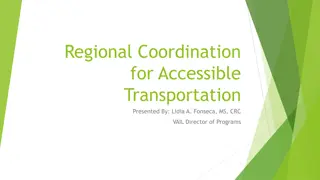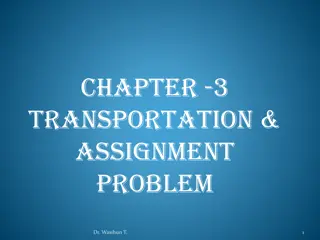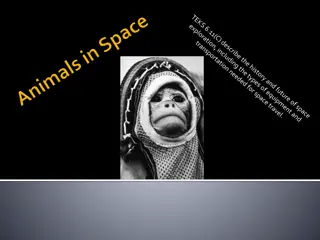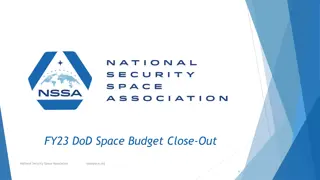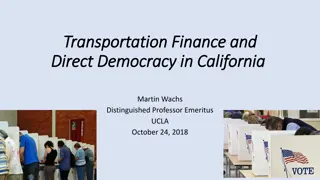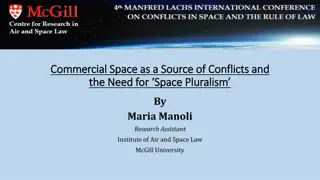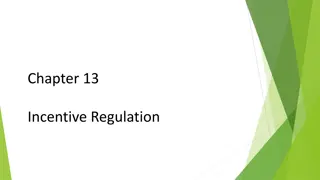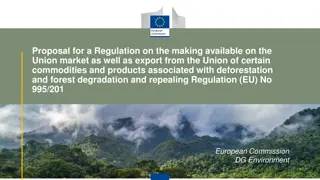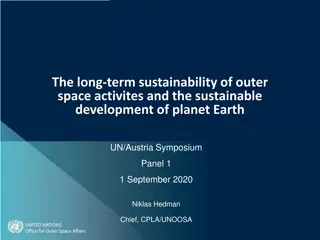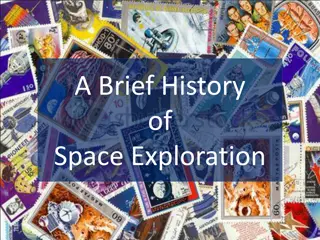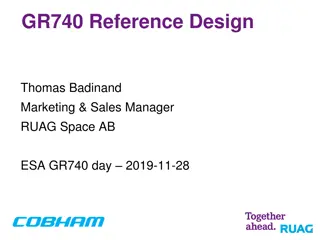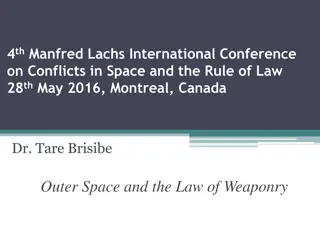Coordination of Regulation in Commercial Space Transportation
Various approaches are being developed for commercial spaceplane flights, necessitating standardization and regulation. Challenges include technical complexities, global institutional involvement, and issues beyond air traffic control. Diverse technical designs in commercial space transportation concepts showcase a wide range of organizations and launch systems.
Download Presentation

Please find below an Image/Link to download the presentation.
The content on the website is provided AS IS for your information and personal use only. It may not be sold, licensed, or shared on other websites without obtaining consent from the author. Download presentation by click this link. If you encounter any issues during the download, it is possible that the publisher has removed the file from their server.
E N D
Presentation Transcript
New Ways Forward to Coordinate the Regulation of the Protozone or Sub Space? By Joseph N. Pelton, Ph.D. Manfred Lachs Conference Montreal, Canada March 16, 2015
Main Points to Cover There are a host of ways now under development for commercial spaceplane flights and thus too early to standardize/regulate. In addition to space tourism there a many new competing applications for subspace or the Protozone and involves different speeds, altitudes. These apps include space adventure flights , hypersonic transport, dark sky stations, robotic freighters and high altitude platforms There are a number of technical challenges, global institutional organizations that need to be involved and a host of issues beyond just Air Traffic Control: ICAO, ITU, WHO, UNEP, WMO, UN COPUOS and UNODA and national entities: FAA/NASA/EPA just in US, EASA and range of European agencies. THE GREAT RISK HERE IS STOVE PIPING. MULTI-DISPLINARY ISSUE Technical Challenges involve: (i) Positioning/Navigation/Timing Satellites & Software plus advanced radar; (ii) Communications and freq. for Air Traffic Control and vital data; (iii) Stratosphere pollution; and (iv) other challenges that will come with tests and start up activities. AGAIN STOVE PIPING ISSUE
Main Points to Cover Experience shows that many can contribute: private foundations (Secure World Foundation), professional organizations (IAASS), university research (FAA Centers of Excellence), companies/commercial entities (Commercial Spaceflight Federation), etc. All can provide part of solution. 3 case studies: Guggenheim Foundation and air safety; Formula 1 Raising and FIA Institute in car racing; and Shipping Classification Societies show that private entities can provide new safety standards and industry regulatory solutions. The problems are complex and we need to draw on expertise everywhere. Model laws; National regulatory bodies such as FAA and EASA, industry, federations and professional organizations, transparency and confidence building measures, and international agencies can help coordinate and share information globally. Don t forget insurance/risk management firms. This is NOT zero sum game.
Diversity of Technical Design Demonstrated in Commercial Space Transportation Concepts to Date Launch Concept Organizations (Some of Which Are Now Defunct or Merged) JP Aerospace and several telecommunications organizations Lighter than Air Ascender- Ion Engine lift from Dark Sky Station and High Altitude Platform Systems (HAPS) Vertical Takeoff / Vertical landing (VTVL) Vertical Takeoff / Horizontal Landing (VTHL) at Spaceport Armadillo Aerospace, Blue Origin, JAXA, Masten Aerospace, Lockheed Martin/EADS Aera Space Tours, Air Boss, Bristol Space Planes, C & Space, Energia, Lorrey Aerospace, Phoenix & Pre-X by EADS, Space Dev, Space Transportation Corp, Space X, Sub Orbital Corp, Myasishchev Corp. Design Bureau, t/Space, Vela Technologies, Wickman Space and Propulsion Horizontal Takeoff / Horizontal Landing(HTHL) Andrews, Scaled Composites, The Spaceship Corporation, Virgin Galactic, XCOR, Project Enterprise by TALIS Institute, DLR, Swiss Propulsion Lab Kelly Space Technology Tow Launch and Horizontal Landing Vertical Launch to LEO from Space Port Launch to LEO from Jet Plane or Carrier Vehicle Drop Alliant, Inter Orbital Systems Technology, Rocketplane/Kistler, Space HAB, UP Aerospace Triton, Stratolauncher, Launcher One (by Virgin Galactic)
Relative Market Size Emerging Protozone Services and their Estimated Market ESTIMATES FOR 2035 Supersonic/Hypersonic Flights into the Extreme Stratosphere $10-100 Bil/yr Commercial launches to low earth orbit $10 Bil/yr Upward Space Tourism/ Space Adventures $ 2 Bil/yr Upward High Altitude Platform Systems-Commercial UAVs $ 1-2Bil/yr Upward Private Space Stations/Habitats $1-2 Bil/yr Upward Proto-Space Transport Robotic Freighters $1 Bil/yr Upward Dark Sky Station/Ion engine lift to orbit $1 Bil/yr Upward
Issues to Address in New Aerospace Systems Issue or Facility Involved Airports servicing HTHL spaceplanes Regulatory/Legal Need Technical Research Need Advanced radar and new GPS Glonass Software Int l Agency Additional Concerns Comment Certification and periodic recertification ICAO Coordi- nation of regular aviation and space flights Air & Space Traffic Management & Control Safety of surrounding area. Liability insurance Safety of surrounding area. Liability insurance Safety of surrounding area. Liability insurance Spaceports supporting HTHL, VTHL, VTVL systems Certification and periodic recertification. Range Safety Control Certification and periodic recertification. Range Safety Control Range Safety Control and High Altitude Range Control Advanced radar and new GPS Glonass Software Advanced radar and new GPS Glonass Software ICAO Launch Sites supporting conventional and commercial rockets Rocket Launch from Balloon or Parachute ICAO Space Traffic Management & Control Advanced radar and new GPS Glonass Software ICAO Air & Space Traffic Management & Control Safety of surrounding area. Liability insurance
Issues to Address in New Aerospace Systems Issue or Facility Involved Rocket Launch from carrier aircraft Regulatory/ Legal Need Technical Research Need Int l Agencies Additional Concerns Comment Range Safety Control and High Altitude Range Control ICAO Space Traffic Manage- ment & Control Space Traffic Manage- ment & Control Space Traffic Manage- ment & Control Safety of surrounding area. Liability insurance Advanced radar and new GPS Glonass Software Rocket Launch from ocean Range Safety Control and High Altitude Range Control ICAO, UNODA Safety of surrounding area. Liability insurance. Advanced radar and new GPS Glonass Software Ion Engine Craft launched from Dark Sky Station Range Safety Control and High Altitude Range Control Stratospheric collisions avoidance systems, Radiation shielding,. Warning Beacons, ICAO Liability insurance Dark Sky Station and Lighter than Air Craft and HAPS New types of certification & recertification plus ATC into Stratosphere. Collision avoidance. Warning Beacons, Advanced radar and new GPS Glonass Software. New frequency allot. ITU and perhaps WMO and UNEP Space Traffic Manage- ment & Control Liability insurance
Issues to Address in New Aerospace Systems Issue or Facility Involved Regulatory/ Legal Need Technical Research Need Int l Agencies Additional Concerns Comment Super Sonic & Hypersonic Transport Air Traffic Control into Stratosphere Sonic Beam mitigation standards, Emission standards, Thermal Protection Systems WMO, UNEP ITU, UNODA Space Traffic Manage- ment & Control Liability provisions, flight path coordination, solar CMEs Radiation Exposure levels/Health Standards Radiation Protection Standards, Flight Path Approvals Ozone hole and Ozone layer investigations World Health Org., WMO, UNDP Genetic mutation Liability provisions, flight path coordination, solar CMEs Rocket Pollutant Emissions (N0x, Cox, Water Vapor Standards for rocket emissions Stratospheric emission studies. Improved propellants WMO. UNDP Climate Incentives for improved propellants. Change, Strato- spheric pollution Orbital Debris (Controlled /uncontrolled reentry) Air Traffic Control and Space Traffic Management Black boxes for all spacecraft. Warning beacons UN COPUOS, IADC, SDA. ITU Greater risk of Kessler Syndrome Fund for debris mitigation. Fines for violations
Issues to Address in New Aerospace Systems Issue or Facility Involved Regulatory/ Legal Need Air Traffic Control into Stratosphere Technical Research Need Additional Concerns Comment Int l Agencies Super Sonic & Hypersonic Transport Sonic Beam mitigation standards, Emission standards, Thermal Protection Sys. Ozone hole and Ozone layer investigations WMO, UNEP and ITU Space Traffic Manage-ment & Control Liability provisions, flight path coordination, solar flares/CMEs Radiation Exposure levels/Health Standards Rocket Pollutant Emissions (N0x, COx, Water Vapor Radiation Protection Standards, Flight Path Approvals Standards for rocket emissions World Health Organization, WMO, UNDP Genetic mutation Liability provisions, flight path coordination, solar flares/CMEs Incentives for improved propellants. Stratospheric emission studies. Improved propellants Black boxes for all spacecraft. Warning beacons WMO. UNDP Climate Change, Stratospheric pollution Orbital Debris (Controlled and uncontrolled reentry) Air Traffic Control and Space Traffic Management & Control UN COPUOS, IADC, SDA Heightened risk of Kessler Syndrome Fund for debris mitigation. Fines for violations
Issues to Address in New Aerospace Systems Issue or Facility Involved Regulatory/ Legal Need Technical Research Need Int l Agencies Additional Concerns Comment Electric Vehicles Emission Standards and Incentives Zero polluting aircraft WMO. UNDP Incentives for low emission aircraft Warning beacons, collision avoidance systems Improveallo ca-tions process Transition planning UAVs & HAPS and robotic freighters Air Traffic Control and Space Traffic Management & Control. RF interference Improved avionics, Emergency override safety systems ITU Improved network management tools Radio Frequency Interference & allocations RF Interference from Air & Space Traffic Control & Mgt Improved Radio systems to avoid interference ITU Coordination processes/ enforcement powers
3 Case Studies The Guggeheim Foundation and Air Safety 1924- 1950s The Formula 1 Racing System. Formation of FIA Institute: Car Racing Safety and Automobile Safety The Shipping Industry Classification Societies. Recognized in federal regulations and essential to obtaining insurance coverage. Moral of story: National legislation or international coordination is not essential to develop key safety practices or standards.
Conclusions There are a wide range of new systems that need to be considered in terms of air & space traffic management and control. These include commercial orbital launches, private space habitats/platforms, dark sky stations, High Altitude Platform Systems (HAPS), Proto-space or sub-space transport, carrier vehicle or jet drop launches, balloon-based rocket launches, towed launched systems, vertical and horizontal launch and landing systems, commercial sub-orbital flights, and hypersonic transportation systems. In the future we may also possibly need to deal with space elevators/funiculars, ion engine-plasma thruster spiral deployment to Geo. This is a set of issues much larger that just space tourism . Protozone regulation is most urgent area.
Next Steps Recognize that there are many regulatory issues and agencies involved. These include: - Air and space traffic safety - Health standards involving radiation & pollution - Environmental safety standards - National defense concerns - Frequency coordination and standards Assign one UN Agency primary responsibility for coordinating regulatory actions (i.e. ICAO??), especially for the Protozone and its safety. Should also create a coordinative process to cover all areas of air and space safety, health standards, environmental pollution, frequency assignments and standards, and even national defense concerns.


